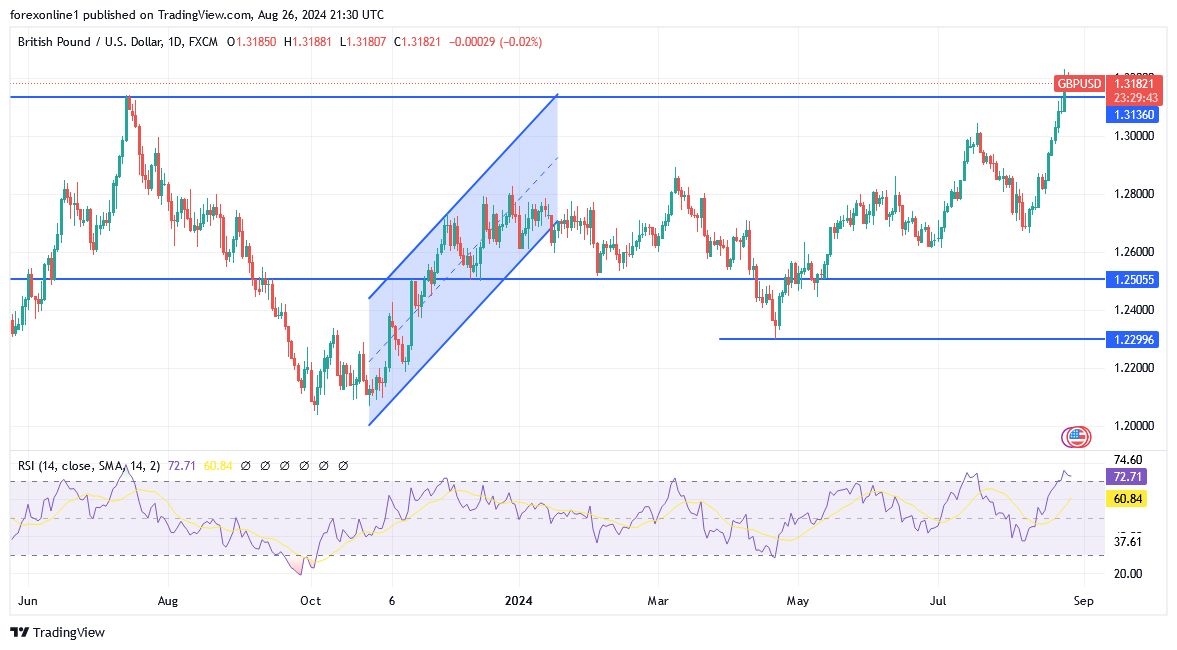- The British Pound reached its highest levels in two years at the end of last week, supported by the Federal Reserve's commitment to cutting US interest rates in September.
- However, the rise seems excessive.
- Jerome Powell, the chairman of the Federal Reserve, couldn't have been more "dovish" in his comments that the time has come to cut US interest rates and that the Fed will do what is necessary to protect jobs.
- The GBP/USD currency pair gains reached the resistance level of 1.3230, the highest in two years, and is stabilizing around the 1.3180 level, awaiting any new developments.

This has signaled a decisive shift from targeting inflation to reducing economic weakness, which would mean lowering interest rates. Now, the question for financial markets is whether the US Federal Reserve will go ahead with a decisive 50bp increase in September or start with a 25bp move.
According to reliable trading platforms, the increased likelihood of a strong 50 basis point hike has led to a decline in the US dollar and the GBP/USD exchange rate has risen to a two-year high. Furthermore, this exchange rate is certainly in a technical uptrend and the most obvious way forward in the coming weeks is higher. However, fatigue is growing, and we are seeing signs of overbought conditions on the charts. In particular, the RSI is at 76 and is significantly extended, increasing the likelihood of a pullback this week. There will be no major data from the UK in the next five days, and we believe that the strength of the action will depend largely on how global markets behave.
With that in mind, it is difficult to be anything other than optimistic now that the Fed has given the green light to cut US interest rates with Powell’s speech sounding so “dovish” that he called for a decisive 50 basis point cut in September.
Technical forecasts for the GPB/USD pair today:
We can expect some overall declines in the markets – and therefore the GBP – in the coming days but ultimately it will be difficult and risky to justify standing in the way of this train. We expect the US dollar to retreat if this week’s data beats expectations and casts doubt on the likelihood of a 50-basis point interest rate hike in September. The highlight will be the release of the US personal consumption expenditures deflator on Friday, a measure of consumer inflation. The Fed tends to watch it closely, but we think there is little chance of a surprise that could change the broader narrative.
For his part, Jerome Powell said in his Jackson Hole speech that he is confident that inflation will not return suddenly and that it is now more focused on the labor market. This suggests that the release of the US non-farm payrolls report in early September will be the next major event for the US dollar.
On the stock trading front, US stock indices faced a volatile session on Monday, with mixed performance across major indexes as investors anticipated upcoming interest rate cuts and focused on Nvidia’s long-awaited earnings report. The Dow Jones closed at a record high while the S&P 500 and Nasdaq 100 fell 0.3% and 1%, respectively, weighed down by losses in technology stocks, especially Nvidia (2.3%) and Tesla (3.2%).
The broader market showed signs of rotating out of technology stocks, with the S&P 500’s energy sector up more than 1%, while technology stocks fell sharply. The shift comes as investors digested a strong signal from Federal Reserve Chairman Jerome Powell that U.S. interest rate cuts are imminent, a move that is expected to impact various sectors differently. Also, investors are looking ahead to earnings reports from Dell, Salesforce, Dollar General and Gap, as well as personal consumption spending data for July on Friday. Meanwhile, the data showed that durable goods orders jumped 9.9% in July, easily reversing a 6.9% decline in June.
Ready to trade our GBP/USD weekly forecast? Here are the best forex trading platforms UK to choose from.
